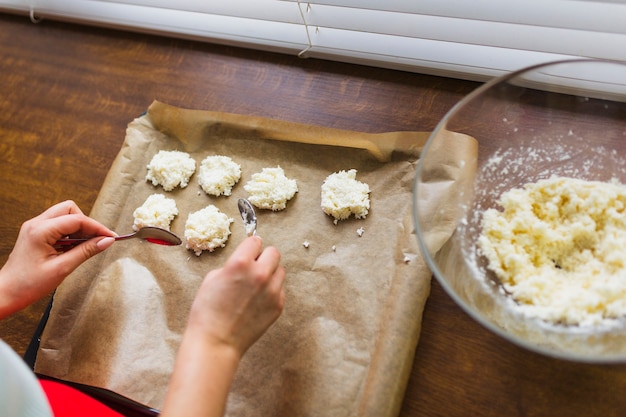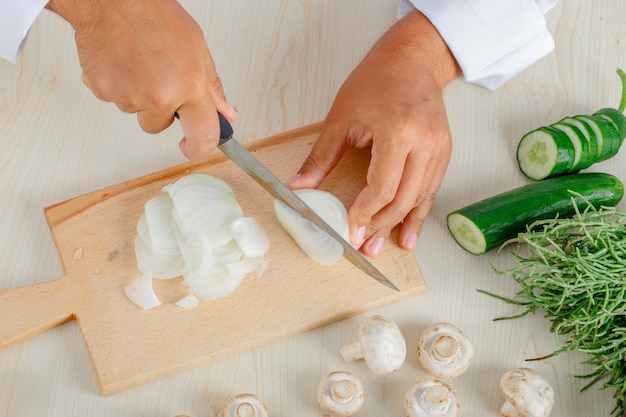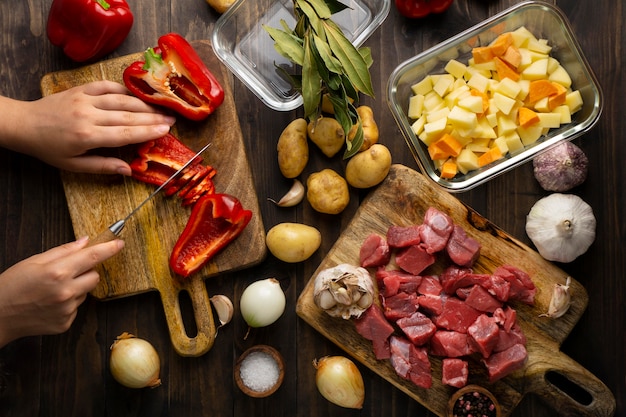Let's talk fufu, shall we? That gloriously chewy, endlessly versatile West African staple that's a true comfort food. I've been making fufu for years, and I've learned it's more than just a recipe – it's an art. It's about mastering the perfect consistency, the subtle nuances of different flours, and the satisfying rhythm of the pounding process. This isn't just a simple recipe; it's an invitation to explore the world of fufu, to understand its origins and its cultural significance, and to discover the joy of creating this delicious dish from scratch. So, gather your ingredients, grab your pounding tools (or your trusty food processor), and let's embark on this culinary journey together.
(Part 1) A Culinary Journey Through Fufu

First, let's define what fufu actually is. It's a dough made from boiled starchy root vegetables, or sometimes flour, that's meticulously pounded or kneaded until it's smooth and springy. It's like a giant edible playdough, but with a richness and depth of flavour that goes far beyond the simple pleasure of molding it.Fufu is a culinary cornerstone in many West African countries, often served with a symphony of soups, stews, and sauces. It's the perfect blank canvas for a dazzling array of flavours, from spicy and bold to delicately sweet and earthy.I remember my first encounter with fufu. It was during a visit to my aunt in Ghana, and she prepared a large pot of fufu made from ground cassava, served alongside a rich, peanut-based soup. It was an awakening! The texture was unlike anything I'd experienced before – firm yet yielding, with a slight chewiness that was incredibly satisfying.That experience ignited a passion for fufu in me, and I've been making it ever since. It's a dish that transcends simple sustenance; it brings people together. It's a communal food, perfect for sharing with loved ones, sparking conversations and laughter around the table.
The Flour Choices: A Spectrum of Textures and Flavours
Let's delve into the heart of fufu making: choosing the right flour. It's like selecting the base note for your culinary symphony. Each flour brings a unique texture and flavour profile to the fufu:
- Cassava flour: This is a popular choice thanks to its accessibility and affordability. It results in a light, slightly sweet fufu with a delicate texture.
- Plantain flour: This flour creates a denser, more robust fufu with a slightly earthy, almost toasty flavour.
- yam flour: Yam flour produces a really smooth and creamy fufu with a subtle nutty flavour. It's known for its melt-in-your-mouth texture.
- Cocoyam flour: A bit more luxurious than the others, this flour creates a wonderfully soft and velvety fufu with a touch of sweetness.
You can even be a culinary adventurer and blend different flours together for a truly unique flavour experience. Imagine the interplay of cassava's sweetness and plantain's earthy depth, or the creamy richness of yam combined with the subtle sweetness of cocoyam. The possibilities are endless! Just remember that different flours have slightly different cooking times and textures, so always consult specific instructions for the flour you choose.
The Art of Pounding: Rhythm, Texture, and Transformation
Now, let's talk about the heart of fufu making: the pounding. This is where the raw flour transforms into a beautiful, cohesive dough. Traditionally, fufu is pounded using a mortar and pestle, a rhythmic and almost meditative process that connects you to the food in a deeply personal way.
For those who prefer a faster approach, a food processor or a stand mixer can be excellent tools. While they might lack the traditional charm of a mortar and pestle, they can still achieve that desired smooth and elastic texture.
Whether you choose the traditional or modern method, there's a satisfying rhythm to pounding fufu. You feel the texture change as you pound, the dough coming together with each forceful motion. It's a testament to the transformation of simple ingredients into something truly special.
Here's a breakdown of the pounding process, no matter your chosen tool:
- Start with a small amount of flour: It's easier to add more flour later than to try to salvage a dry dough.
- Gradually add water: Adding water in small amounts gives you greater control over the consistency, ensuring that you don't end up with a soggy mess.
- Don't over-pound: The goal is a soft and pliable dough, not a dense, dry brick. If it starts to feel too firm, add a little more water.
- Seasoning matters: A pinch of salt is essential for enhancing flavour and aiding in preservation.
The ideal fufu should have a consistency similar to playdough. It should be soft enough to mold into balls and easily shape, yet firm enough to hold its shape. If it's too dry, add a little more water. If it's too wet, add more flour. It's all about finding that perfect balance, which comes with practice and a bit of intuition.
(Part 2) The Essential Ingredients: A Simple Yet Crucial Cast

Now, let's talk ingredients, the components that come together to create this wonderful dish. You'll find most of these at your local African grocery store or even some mainstream supermarkets.
The Star of the Show: Flour
As we've established, the key ingredient is the flour. Choose from cassava, plantain, yam, or cocoyam flour, or experiment with blends for a personalized touch.
The Unsung Hero: Water
Water is crucial for both boiling the flour and for the pounding process. Use fresh, clean water, as it will be incorporated into the fufu itself.
Optional Extras: Adding Depth and Complexity
These are not mandatory, but they can elevate your fufu to a new level of deliciousness.
- Salt: A pinch of salt is essential for flavour and preservation.
- Oil: A small amount of oil can prevent the dough from sticking to your pounding tools, ensuring a smoother process.
- Sugar: If you prefer a sweeter fufu, a small amount of sugar can be added to the dough.
- Spices: Get creative with spices! Ginger, garlic, turmeric, or even a pinch of chili powder can add layers of flavour. Just remember to add spices to the dough before pounding.
Remember, these are just suggestions. Experiment, find what you love, and make this recipe your own!
(Part 3) Making Fufu: A Step-by-Step Guide to Culinary Success

Ready to get your hands dirty? This is a basic recipe for cassava fufu, a great starting point for your fufu journey. Once you've mastered this, you can explore other flours and personalize it with your own flavour combinations.
What you'll need:
- 1 cup cassava flour
- 2 cups water
- Pinch of salt
- Optional: 1 tablespoon oil
Instructions:
1. Boil the water: Bring the water to a rolling boil in a large pot.
2. Add the flour slowly: Gradually sprinkle the cassava flour into the boiling water, stirring constantly with a whisk or wooden spoon. The goal is to prevent lumps from forming.
3. Simmer and stir: Reduce the heat to a simmer and continue stirring for about 5 minutes, or until the flour is cooked through and the mixture has thickened.
4. Cool slightly: Remove the pot from the heat and let the mixture cool slightly.
5. Pounding time: Transfer the cooked flour mixture to your chosen pounding tool (mortar and pestle, food processor, or stand mixer). Add a pinch of salt and, if desired, a tablespoon of oil.
6. Pound until smooth and elastic: Pound or mix the dough until it's smooth, elastic, and firm. Add small amounts of water as needed to achieve the desired consistency.
7. Serve immediately: Once the fufu is ready, serve it hot with your favourite soup, stew, or sauce.
Congratulations, you've made your own fufu! Enjoy the fruits of your labour!
(Part 4) Tips and Tricks for Fufu Perfection
Fufu making is a skill that takes practice and a bit of culinary intuition. But don't worry; I'm here to share some hard-earned tips and tricks to help you achieve fufu perfection.
Avoiding Lumpy Disasters
The biggest challenge for beginners is often avoiding those pesky lumps. Here are a few strategies to help you achieve a smooth and seamless fufu:
- The power of a whisk or wooden spoon: When adding the flour to the boiling water, use a whisk or wooden spoon and stir vigorously and constantly. This helps prevent the flour from clumping together.
- A slow and steady approach: Don't dump the flour in all at once. Add it gradually, in small amounts, and keep stirring.
- Sieving for smoothness: Sieve the flour before adding it to the water to remove any lumps and ensure even cooking.
Mastering the Art of Consistency
Another key aspect of fufu making is achieving the perfect consistency. It should be soft and pliable, but not too wet or too dry.
- Water in small amounts: When pounding the dough, add small amounts of water at a time to maintain control over the consistency.
- Beware of over-pounding: Over-pounding can make the dough hard and dry. If it starts to feel too firm, add a little more water.
- Touch is key: Use your hands to feel the dough as you pound. It should be smooth and cohesive, not crumbly or sticky.
Keeping it Warm and Delicious
Fufu is best enjoyed hot, so it's important to keep it warm while you're preparing your other dishes.
- Foil is your friend: Once the fufu is ready, wrap it tightly in aluminum foil to retain its heat.
- A warming tray to the rescue: Place the fufu on a warming tray to keep it at a comfortable temperature.
- Serve immediately for optimal enjoyment: If you're not going to serve it immediately, store it in a covered container to preserve its warmth.
Remember, practice makes perfect! The more you make fufu, the better you'll become at getting that perfect consistency and flavour.
(Part 5) Beyond the Basics: Variations and Flavour Exploration
Now that you've mastered the fundamental fufu recipe, let's explore some exciting variations and flavour combinations that will take your fufu game to the next level.
Flavourful Additions: A World of Possibilities
As mentioned earlier, you can add various ingredients to your fufu to enhance its flavour. Here are a few ideas to inspire you:
- Spices: Experiment with ginger, garlic, turmeric, or even a pinch of chili powder for a bit of heat. Add these to the dough before pounding.
- Fresh herbs: Parsley, cilantro, or chives can add a burst of freshness and flavour. Add them to the dough or sprinkle them on top just before serving.
- Nuts: Roasted and ground peanuts or almonds can add a nutty flavour and texture. Add these to the dough before pounding.
- Vegetables: You can even add finely chopped vegetables to your fufu. Carrots, onions, or peppers can bring a delightful crunch and vibrant colour.
Different Flours, Different Flavours: A Culinary Adventure
We've talked about cassava flour, but there's a whole world of flours waiting to be explored. Each has its own unique texture and flavour profile:
- Plantain flour: This flour gives you a denser, more robust fufu with a slightly earthy flavour.
- Yam flour: Yam flour makes a really smooth and creamy fufu. It has a slightly nutty flavour.
- Cocoyam flour: This flour is a bit more expensive than the others, but it produces a wonderfully soft and velvety fufu with a subtle sweetness.
- Mixed flours: Combine different flours to create your own unique blends. Imagine the interplay of cassava's sweetness and plantain's earthy depth, or the creamy richness of yam combined with the subtle sweetness of cocoyam.
Experiment with different flours, and discover your own favourites! You'll be amazed at the variety of textures and flavours you can achieve.
(Part 6) Fufu and its Companions: A Symphony of Flavours
Fufu is a versatile dish that pairs beautifully with a wide array of soups, stews, and sauces. It's the perfect culinary canvas for a variety of flavour profiles.
Soups and Stews: A Culinary Embrace
Here are a few classic pairings for fufu:
- Light soup: A refreshing soup made with vegetables, fish, or chicken, offering a light and delicate counterpoint to the fufu's chewiness.
- Peanut soup: A rich and flavourful soup made with ground peanuts, vegetables, and meat or fish. It complements the fufu's texture with its creamy depth.
- Egusi soup: A hearty soup made with ground melon seeds, vegetables, and meat or fish. It brings a robust flavour and a satisfyingly thick texture to the table.
- Ogbono soup: A thick and flavourful soup made with ground ogbono seeds, vegetables, and meat or fish. It's a culinary symphony of bold flavours and textures.
Sauces: A Splash of Colour and Boldness
You can also enjoy fufu with various sauces:
- Tomato sauce: A classic sauce made with tomatoes, onions, garlic, and spices. It offers a bright and tangy counterpoint to the fufu's subtle sweetness.
- Palm oil sauce: A rich and flavourful sauce made with palm oil, tomatoes, onions, and spices. It adds a layer of complexity and depth to the overall flavour profile.
- Pepper sauce: A spicy sauce made with peppers, onions, and spices. It brings a fiery kick to the table, perfect for those who love a bit of heat.
Remember, there's no right or wrong way to enjoy fufu. It's all about personal preference. Experiment with different pairings and discover your own favourite combinations.
(Part 7) Fufu Beyond the Kitchen: Cultural Significance and Heritage
Fufu is much more than just a delicious meal; it's a profound reflection of West African culture, history, and tradition. It's a symbol of community, heritage, and shared culinary history.
A Culinary Heritage: Passed Down Through Generations
Fufu has been a staple food in West Africa for centuries. It's a dish that has been passed down through generations, woven into the fabric of West African life.
For many West Africans, fufu represents a powerful connection to their roots, their family, and their heritage. It evokes feelings of nostalgia, warmth, and belonging.
A Symbol of Community: A Gathering Force
Fufu is a communal food. It's often prepared and shared among family and friends, creating a sense of unity and togetherness. It's a dish that encourages conversation, laughter, and storytelling.
Fufu is more than just a meal; it's an opportunity to connect with loved ones, to share stories, and to celebrate life together.
Beyond the Plate: A Symbol of Hospitality and Abundance
Fufu also plays a prominent role in West African ceremonies and celebrations. It's a symbol of hospitality and abundance, often served at weddings, funerals, and other special occasions.
Fufu is not just a dish; it's a cultural treasure, a testament to the rich culinary heritage of West Africa. It's a dish that speaks volumes about the history, traditions, and values of a vibrant and diverse culture.
(Part 8) Fufu for Everyone: Inclusivity and Health
Fufu is a dish for everyone. It transcends cultural boundaries and dietary restrictions, offering a delicious and satisfying meal that everyone can enjoy.
Dietary Considerations: A Dish for Many
Fufu can be adapted to accommodate various dietary needs, making it accessible to a wide range of people.
- Gluten-free: Fufu is naturally gluten-free, making it a great option for those with celiac disease or gluten sensitivity.
- Vegan: Fufu is vegan-friendly when made with plant-based ingredients and served with a vegan soup or sauce.
- Vegetarian: Fufu can be enjoyed with a vegetarian soup or sauce, making it a delicious option for vegetarian diets.
Health Benefits: A Nutritious Choice
Fufu is also a nutritious and healthy meal. It's a good source of carbohydrates, dietary fiber, and vitamins.
- Carbohydrates: Fufu is a great source of energy, providing the body with sustained fuel.
- Dietary fiber: Fiber helps to promote digestive health, keeping things moving smoothly.
- Vitamins: The root vegetables used to make fufu are rich in vitamins, such as vitamin C, vitamin A, and vitamin B, contributing to overall health and well-being.
Fufu is a versatile, delicious, and nutritious meal that can be enjoyed by everyone. So, what are you waiting for? Embark on your own fufu journey, and discover the joy of creating and sharing this incredible dish.
FAQs
1. What is the best type of flour for making fufu?
The best type of flour for making fufu depends on your personal preference. Cassava flour is a popular choice because it's readily available and relatively affordable. It results in a light, slightly sweet fufu. Plantain flour gives you a denser, more robust fufu with a slightly earthy flavour. Yam flour makes a really smooth and creamy fufu with a slightly nutty flavour. Cocoyam flour produces a wonderfully soft and velvety fufu with a subtle sweetness. You can also experiment with blends of different flours to create your own unique fufu.
2. How do I know if my fufu is ready?
Your fufu is ready when it's smooth, elastic, and firm. It should be soft and pliable enough to roll into balls and easily mold. If it's too dry, add a little more water. If it's too wet, add more flour.
3. What can I serve with fufu?
Fufu is a versatile dish that pairs perfectly with a variety of soups, stews, and sauces. Popular pairings include peanut soup, egusi soup, ogbono soup, tomato sauce, palm oil sauce, and pepper sauce. You can also enjoy it with a light soup made with vegetables, fish, or chicken.
4. Can I store leftover fufu?
Yes, you can store leftover fufu. Place the fufu in an airtight container and refrigerate it for up to 3 days. To reheat, simply place it in a microwave-safe container and heat it on high for 30-60 seconds, or until heated through.
5. How can I make my fufu less sticky?
To prevent your fufu from sticking, add a small amount of oil to the dough before pounding. You can also use a lightly oiled mortar and pestle or food processor bowl.
Everyone is watching

Perfect Rice Every Time: The Ultimate Guide to Cooking Rice
Cooking TipsAs a self-proclaimed foodie, I've always been a bit obsessed with rice. It's the foundation of countless cuisi...

Ultimate Guide to Cooking the Perfect Thanksgiving Turkey
Cooking TipsThanksgiving. Just the word conjures up images of overflowing tables laden with delicious food, the scent of r...

The Ultimate Guide to Cooking Asparagus: Tips, Techniques, and Recipes
Cooking TipsAsparagus. The mere mention of this spring delicacy conjures up images of vibrant green spears, crisp and burs...

Can You Cook Spaghetti with Gasoline? (The Shocking Truth)
Cooking TipsWe've all seen those crazy internet trends. You know, the ones that make you wonder, "Did someone actually try...

Chorizo and Eggs Recipe: The Ultimate Guide
Cooking TipsRight, let’s talk about chorizo and eggs. You know, that classic Spanish dish that's always a winner. It's th...
